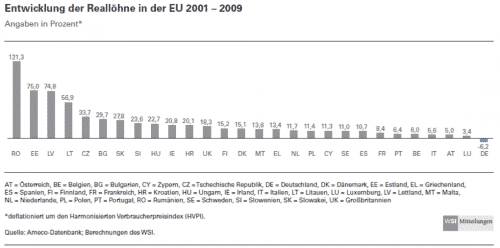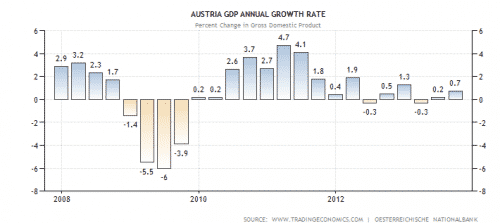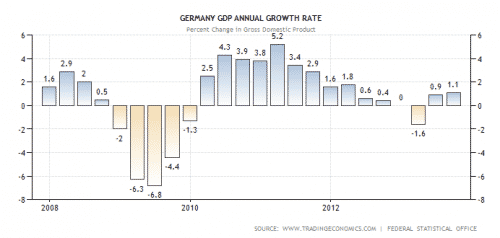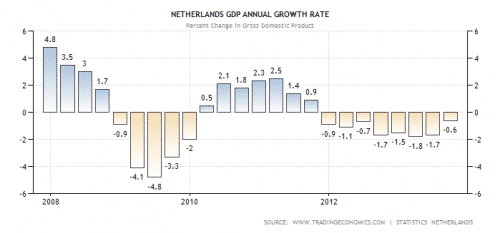A country breakdown as global growth accelerates: Germany, Austria, France, Netherlands
Note: this the last in a series of country views. See parts 1 and 2 here
I believe, as many economic analysts do, that global growth is accelerating. Backing that up, two days ago I looked at four economies where growth has been good. But, yesterday, I looked at four economies where growth has been poor and big problems remain. Today I want to look at four more and sum up.
I am going to leave it at four due to time and space constraints but I am using these four as being representative of core Europe, whereas yesterday I looked at the periphery and Japan. While the outlook in the core is better than it is in the periphery, there are some glaring weaknesses and I want to start with Austria to show one.
Austria
Austria is doing well. It has the lowest unemployment level in the eurozone at 4.8%, the second lowest youth unemployment in the EU behind Germany at 9.4%, and low long-term unemployment at 1.1%. GDP has been growing in Austria since the financial crisis ended, with only two minor quarterly blips. And inflation has been low. Austria’s credit rating is still AA+ and it enjoys a very low spread to Germany. The government debt and deficit picture with 74% debt to GDP and a 2.5% of GDP deficit is better than Germany’s. Along with Germany and the Netherlands, it was one of the surplus countries during the period of pre-crisis macro imbalance.
Underneath this picture lie problems and the most important one in my view is wage growth. According to Austrian daily Kurier, since 2010 wages have stagnated or declined right across Europe. Austria is no exception. This year, real wages have grown only 0.1%. Austria was a country that had one of the slowest growth in wages in Europe in the previous decade, with real wages rising 5.0% from 2001-2009. Only Luxembourg and Germany were slower. Graphic in German below.
The union-favouring German Economic and Social Sciences Institute says this in response:
“Declining real wages was a German phenomenon. Lately however, the negative trend has caught a large portion of Europe.”
And this is the problem with the economic model in Europe. It is based on suppressing wages, largely to increase external competitiveness for export. Some people call this mercantalism. But irrespective of the name, the consequences are slow domestic demand growth, something that is problematic in the face of undercapitalized financial institutions, even in Austria.
My view here is that this economic model ends up pitting business owners against workers because it relies on suppressing labour costs to be effective. And to the degree it is effective, we will see this via a rising external balance and an increasing gap between gross domestic product and gross domestic expenditures. Given the wage suppression, all of the profit associated with this goes to the exporting business owners even while GDP growth remains weak.
Germany
Germany is the progenitor of this model. I have explained the impetus for this economic model arising from Germany’s post reunification soft depression and the uncompetitiveness of labour, particularly in eastern Germany after the Lohnangleuichung. I am a label reader and noticed the shift in production that began after re-unification from manufactured goods labels. If you lived in or visited Germany during this time, you could see toys like Schleich miniature animals start to get manufactured in China or housewares from Braun start to get manufactured in Hungary or Bulgaria. It was an inexorable shift of production abroad that was killing both the eastern states and the industrial powerhouse Rhein-Ruhr region of Nordrhein Westfalen in western Germany.
I have argued that pre-crisis the German model produced an unsustainable vendor financing dynamic within the eurozone that ended inevitably in crisis. The Germans learned from this as GDP in Germany plunged during the crisis. Germany has turned its export orientation toward emerging markets, and has prospered accordingly.
For example, the German carmakers are cleaning up in China. We are seeing record figures there, with the Germans taking one fifth of the market. The sales have increased seven-fold since 2005. That’s huge. It also explains why the Germans have shifted focus to China and away from the periphery. Yes, the problems in the periphery have taken their toll on German growth and led to a European double dip – as I predicted. Nevertheless, it hasn’t been terrible for Germany. Its export prowess remains. Exports recently hit a record high.
And German domestic demand is improving as wage suppression has been lifted to a degree. Labor costs are rising in Germany above the average in the eurozone at 2.8% versus 2.2% in the first half of 2013. By contrast, In 2012 for example, labor costs sank 5.8% in Greece and 4.9% in Portugal as they attempted internal devaluation. And Germany recently decided to enact a minimum wage of 8.50 euros per hour on par with rates in France, the Netherlands and Ireland as a compromise in coalition talks. Higher wages have meant lower savings rates. The German savings rate is at 8.5%, its lowest level since 2001. That is bolstering consumption.
Analysts are now raising economic forecasts for Germany as a result. Nothing I see right now points to weaknesses in Germany’s domestic economy which would cause the Germans to switch tack on their economic model or overall European positions.
As with Austria, the seedy underbelly here is that wage suppression has led to wage inequality and to wealth inequality. This wage inequality is rising everywhere in Europe, as the German economic model takes hold. And recently German unemployment rose to the highest level in 2 1/2 years.
France
In France, business people want what Germany has. The French business roundtable leader Perre Gattaz recently said he wants reforms in French labor markets like the ones Germany got under Gerhard Schröder – meaning he wants wage suppression and internal devaluation to boost French competitiveness. But France isn’t going to get there soon. The news has improved of late, but the numbers last month were horrific. Unemployment was at a historic high with a record unemployed in France of 3.29 million. The economy was contracting as businesses held off capital investment and factory orders were shrinking at a faster rate, statistics showed. This led to France’s sovereign debt being downgraded to AA by S&P.
My hope is that France is turning a corner though. The OECD doesn’t see unemployment coming down measurably until 2015. . But unemployment declined recently for the first time in 30 months, with a reduction of 0.6% of unemployed to 3,275,200 in October, according to the most recent figures. Let’s see where this heads.
The major headwind I see in France is the housing market. French house prices are down 1.4% y-o-y. As in the Netherlands, where the fall has been much greater, house price falls are a hidden drag on the economy that is little discussed in the English-language press. Post-bubble, France was one of the few markets that had risen a lot before the crisis which had yet to have a significant housing downturn. This is stark contrast to the Netherlands where the downturn is biting. In today’s links, I posted an article from the Wall Street Journal’s Canadian blog which details over- and undervaluation in house prices globally according to Deutsche Bank.
Deutsche Bank: The US remains fairly valued in housing. But Norway, Canada, UK, Belgium, Sweden are overvalued pic.twitter.com/BBOVPAXYVP
— Edward Harrison (@edwardnh) December 12, 2013
The top six and top eight of ten countries on Deutsche Bank’s overvalued list have not had major housing busts during the crisis
— Edward Harrison (@edwardnh) December 12, 2013
France is on this list with an overvaluation of 33%, a measure that is very much in line with what I have seen from the Economist and the Telegraph in previous global surveys of this nature.
The Netherlands
We can see what happens when your housing market overheats and busts in the Netherlands. And this provides a cautionary tale for France since the Netherlands had usually been grouped with Germany and Austria in terms of positive macroeconomic fundamentals. But it has been stripped of its AAA rating by S&P because the macro outlook is poor.
I don’t really need to talk in depth about the Netherlands because this chart sums up what has happened as the household sector has deleveraged, post-bust.
This is what countries like France, Sweden, Norway, Canada or Belgium are trying to avoid!
Conclusions
This post and the two prior posts show uneven growth within the global economy. I really only looked at Europe, the US, Japan and China, so the emerging markets got short shrift. But the picture, while uneven, is mostly positive on a cyclical basis. Notice, however, that in Europe, even where things should be good – Sweden, Austria, the Netherlands, etc, there are problems. The economic model that Europe is using in the eurozone in particular is deflationary. The aim is to boost competitiveness by keeping labor costs down. Not only does this lower domestic demand in the absence of debt accumulation, it also acts redistributionally by giving all the gains of globalization to the owners of business while gains to ordinary workers remain relatively modest.
I don’t know how much longer this can go on without a hiccup. But I do think there is forward momentum. I expect growth in 2014 to be better than 2013, with Europe and Japan as the laggards. Eventually, however, the lack of wage growth will become a problem. And I believe poor wage growth plus high private debt and falling asset prices will create an unanticipated crisis come the next cyclical downturn.




Comments are closed.